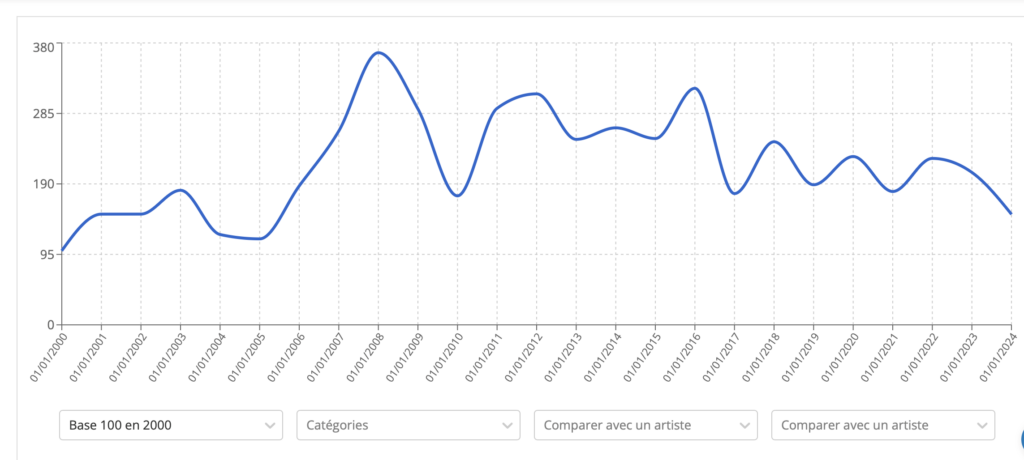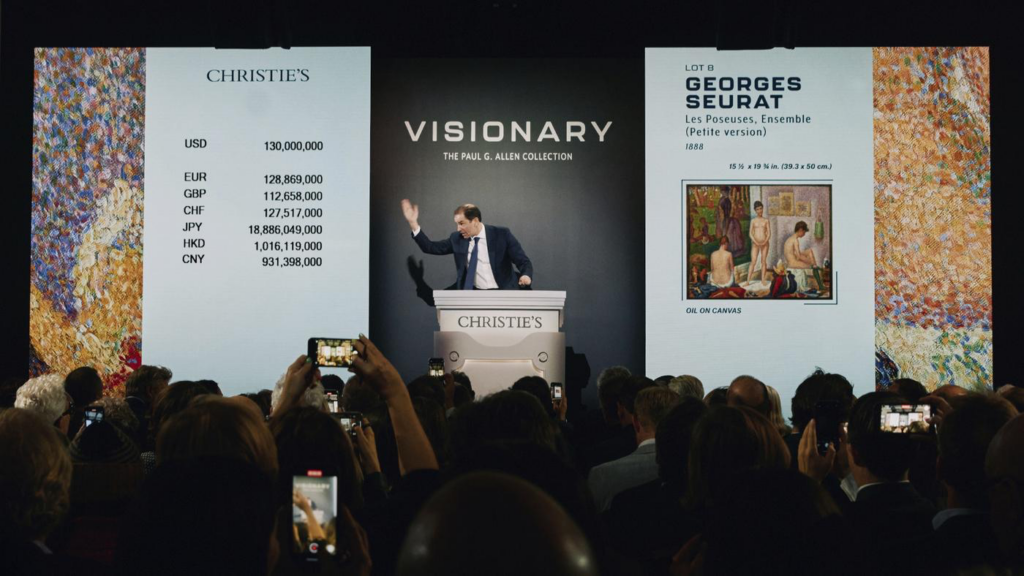What factors contribute to the fluctuation in an artist’s valuation?
“Determinants Influencing an Artist’s Rating on the Art Market”
The art market is governed by a myriad of factors that determine an artist’s value and rating. Understanding these elements is essential for aspiring artists and collectors keen on tracking market trends.

©Artprice.com
Let’s delve into the seven key factors influencing an artist’s rating:
Evolution in Style or Artistic Direction
During the early stages of their careers, artists undergo intense exploration, seeking to uncover their distinctive style, their artistic essence. Therefore, stylistic and artistic shifts constitute pivotal moments in an artist’s career. They reflect their evolution, their constant quest for authentic expression, and their capacity for reinvention.
A shift approved by critics and collectors can propel the artist towards new heights of recognition and value, leading to an increase in their rating.
Increased Recognition
As an artist ascends the ladder of recognition through major exhibitions, features in renowned art journals, or prestigious artistic accolades, it translates into an upward trajectory in their artistic rating.
The spotlight on their work captures the attention of connoisseurs and collectors, generating growing interest that often results in an appreciation of the artist’s rating. Each accolade received, each prestigious exhibition serves to legitimize and enhance the perceived value of their work in the art market.

© Getty – Thierry Chesnot/Getty Images
Exhibition and Auction Results
The outcomes of an artist’s solo exhibitions and the performance of their works at auctions play a crucial role in determining their rating. Each success achieved at these events enhances the artist’s reputation and consolidates the perceived value of their work in the art market.
Every high price achieved and every successful sale are testimonies to the increasing demand for their works, contributing to an elevation in their rating. Exhibition and auction results also provide artists with direct feedback from the public and buyers, offering valuable insights into the reception of their work and its market appeal.
Renowned Collectors
When renowned collectors begin investing in an artist’s works, it significantly impacts their rating. The recognition from these collectors puts a stamp of approval on the artist’s work, attracting the attention of other collectors and amplifying the perceived value of their art in the market.
Each acquisition by an influential collector helps solidify the artist’s reputation and stimulates demand for their works.

© Christie’s images limited 2022.
Critics and Media
The impact of art critics and the media on an artist’s career cannot be underestimated. Praise from a respected critic or favorable media coverage can not only elevate the artist’s notoriety but also reinforce the perception of the quality and value of their work.
These articles contribute to shaping the artist’s public image and increasing interest in their work, often resulting in a significant increase in their rating in the art market.
Supply and Demand
The balance between supply and demand is a crucial factor in determining the prices of artworks. When demand for an artist’s works exceeds the available supply, it creates a conducive environment for an increase in their rating.
Collectors, eager to own a rare piece, are willing to pay a higher price to secure a coveted work. Conversely, if supply exceeds demand, the artist’s rating may suffer as buyers have more choices and are less inclined to offer high prices.
Thus, the balance between supply and demand is a crucial indicator of an artist’s perceived value in the art market.

© Art Market Magazine
Front cover: Bianca Severijns
© Sister Litay. 2017
Art Market Trends and Fluctuations
Fluctuations in the art market are a major factor influencing the rating of artists. When the market is booming, with sustained demand and rising prices, it can be beneficial for the rating of many artists as the perceived value of their works increases in line with the market. However, during an economic downturn or other factors leading to a decrease in demand or buyer confidence, it can have a negative impact on the value of artworks in general, and thus on the rating of artists.
Therefore, the overall health of the art market is a key indicator to monitor in understanding artists’ rating trends.
In conclusion, an artist’s rating in the art market is the complex result of various factors, ranging from critical recognition to the state of the market and collectors’ demand. A thorough understanding of these elements is essential for successfully navigating the world of contemporary art.
